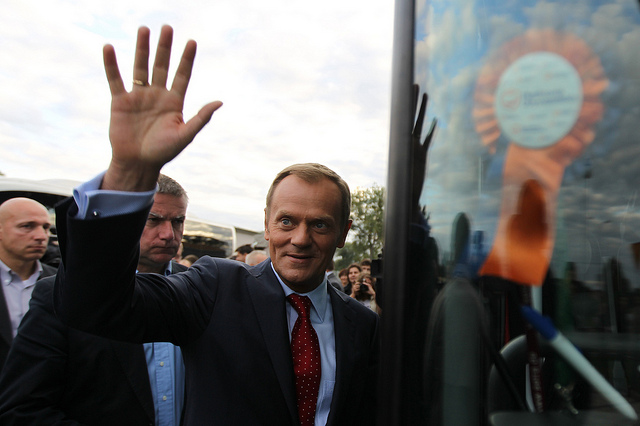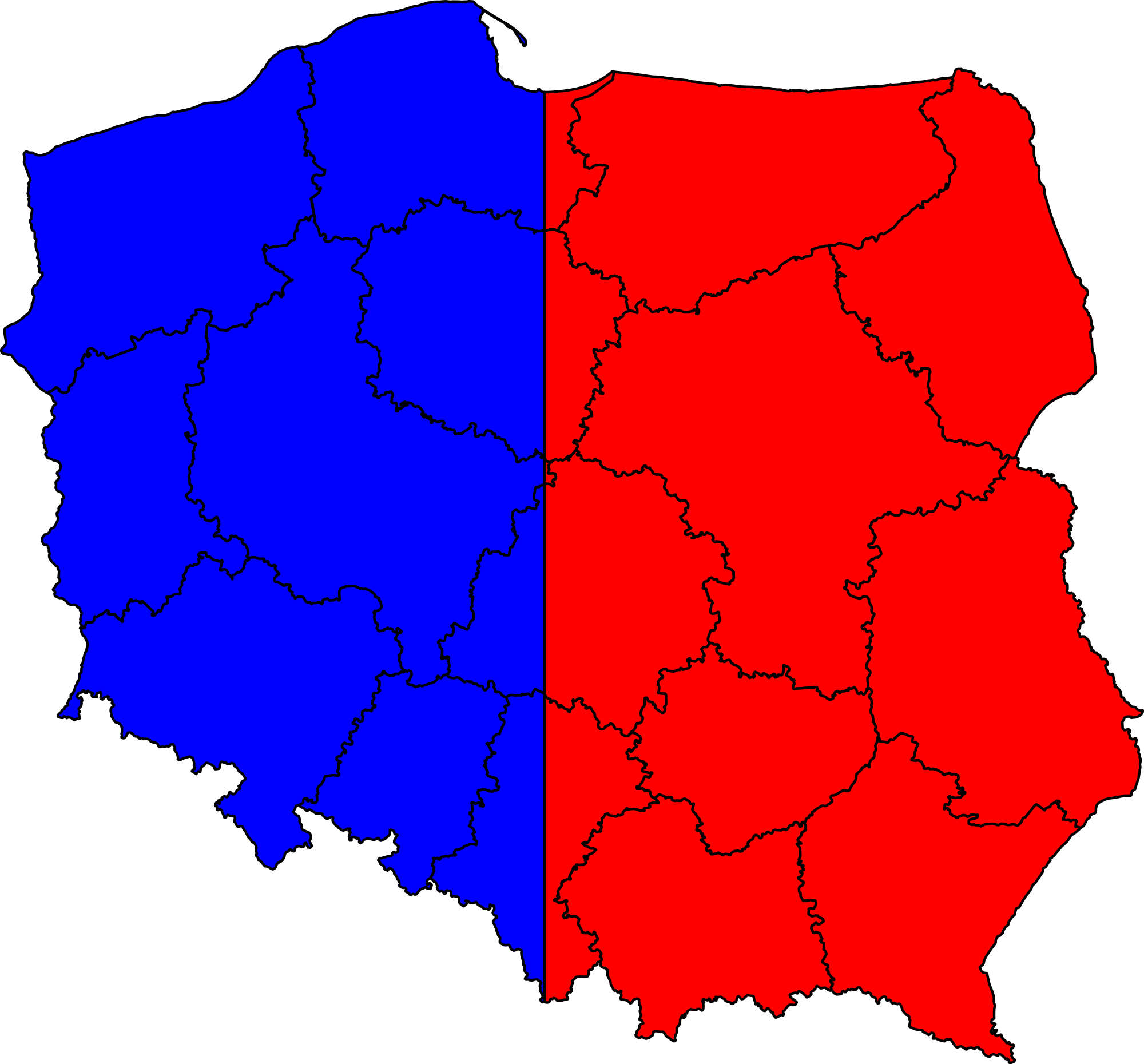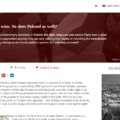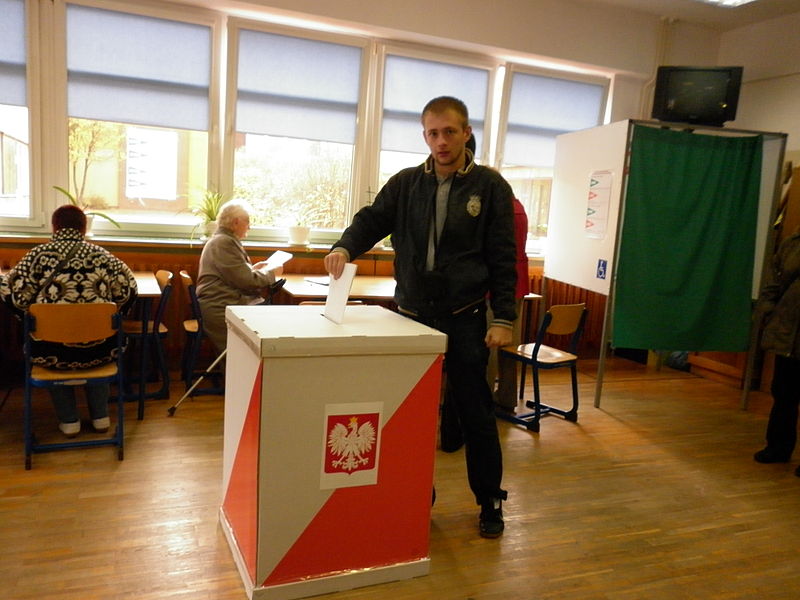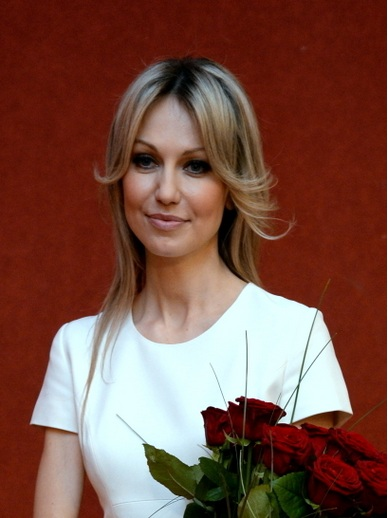Since the fall of the communism Poland is facing a substantial challenges. From Balcerowicz’s plan, throughout reformation of fundamental pillars of the state, accession to NATO and European community to oncoming EU presidency, the centre-right political parties are playing a significant role in the history. Although till 2007 on every consecutive elections power was shifted from right to left or vice versa, even the post-communist governments were following the pro-European path layed out by the first non-communist prime minister Tadeusz Mazowiecki, who first expressed that will, and minister of foreign affairs Krzysztof Skubiszewski who declared that Poland was determined to become a member of the European Community1.
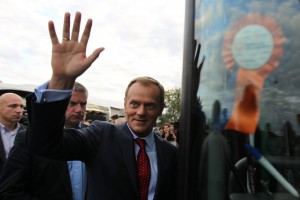 After initial period of euphoria and young, immature democracy, centre-right politicians experienced a cold shower. In spring 1993 the economical and moral scandals leaded to dis-popularity of Hanna Suchocka’s government. At the initiative of “Solidarność” parliament voted for no confidence to her Cabinet. Next day president Lech Wałęsa dissolved the parliament. Although it was a kind of surprise for most of observers and players on the political scene, everyone hoped that it will be profitable to him – Wałęsa counted a electoral success of his Bezpartyjny Blok Wspierania Reform2, all political parties also hoped to gain more support in the oncoming elections3. But the election outcome resulted in complete reconstruction of the political scene. Firstly, thanks to new proportional electoral law, most of the political “plankton” found themselves outside the parlament4 which was a qualitative change in relation to previous parliament, which was constructed of 29 parties5. But the most shocking outcome was a victory of the post-communist coalition Sojusz Lewicy Demokratycznej6 along with Unia Pracy7 and Polskie Stronnictwo Ludowe8, also associated with a previous era9.
After initial period of euphoria and young, immature democracy, centre-right politicians experienced a cold shower. In spring 1993 the economical and moral scandals leaded to dis-popularity of Hanna Suchocka’s government. At the initiative of “Solidarność” parliament voted for no confidence to her Cabinet. Next day president Lech Wałęsa dissolved the parliament. Although it was a kind of surprise for most of observers and players on the political scene, everyone hoped that it will be profitable to him – Wałęsa counted a electoral success of his Bezpartyjny Blok Wspierania Reform2, all political parties also hoped to gain more support in the oncoming elections3. But the election outcome resulted in complete reconstruction of the political scene. Firstly, thanks to new proportional electoral law, most of the political “plankton” found themselves outside the parlament4 which was a qualitative change in relation to previous parliament, which was constructed of 29 parties5. But the most shocking outcome was a victory of the post-communist coalition Sojusz Lewicy Demokratycznej6 along with Unia Pracy7 and Polskie Stronnictwo Ludowe8, also associated with a previous era9.
This was a break-point for a right side of the political scene. They realised that they have to consolidate if they want to have any impact on Polish politics. That crystallisation was concentrated in two centres – one closer to the centre which can be associated with Donald Tusk, and another one more to the right, closer to Solidarność trade union and leaded by Jarosław Kaczyński. Before next elections in 1997 the right side of the policital scene incorporated Unia Wolności10 – which arisen from merge of Tusk’s Kongres Liberalno-Demokratyczny11 and Unia Demokratyczna12 – and Akcja Wyborcza Solidarność13, broad fusion of more than 3014 conservative, right-wing and centre organizations incorporating Solidarność trade union and Jarosław Kaczyński’s Porozumienie Centrum15. Participation of Solidarność Trade Union in AWS was a clear sign of weakness of the political parties in Poland16.
UW attached weight to the idea of the civic society, neutral outlook of the state and separation of the church and the state and it was supporting polish aspirations to NATO and EU17 and it was a heir of liberal wing of the Solidarność trade union while AWS belonged to stream of Christian democracy with views on certain issues similar to this of the conservative right18. The former prime minister’s Jan Olszewski’s Ruch Odbudowy Polski19 remained the only alternative at this side of the political scene as other right-wing parties operated on the margin of the politics or disintegrated. AWS and UW won 1997 elections and created a coalition government with Jerzy Buzek as a prime minister. As both coalitians agreed that radical changes are needed (PC and their associated from AWS wanted to create a “New State”, strongly rooted in traditional values yet modern and powerful state of big authority20 while UW wanted to ward off the threat of squandering the reforms which are conducted with a great effort of the whole society for last 5 years21), Jerzy Buzek’s government marked its place in history as a cabinet drawing visions of daring reforms without looking back for the means to realise them and public support22. Despite this fails, some reforms, like restructurisation of mining industry or administrative reform, which created 16 new big districts in place of 49 small ones, proved to be successful2324. But the big mistake of introducing so many important reforms at the same time and without proper analysis resulted in 90 000 000 zł “hole” in state’s budget25.
Both members of the coalition paid a price. In UW Bronisław Geremek election for a new leader resulted in former KL-D members quiting the party. They considered it as a further marginalisation of the liberal wing within UW. Most of the young party members followed them26. They co-created Platforma Obywatelska27, which apart of the known names from centre-right attracted many of people from the local councils, such as extremely popular president of Wrocław Bogdan Zdrojewski, and other people not previously involved in politics. After few weeks from establishing PO had 20% of the popular support28. AWS was falling apart as well. The last nail to its coffin were criminal and political scandals with most significant case of Jacek Dębski, former chairman of the Office for the Physical Culture and Sport who disclosed that prominent AWS politician was pushing him to find some informations regarding president Aleksander Kwaśniewski (in the 80’s he was Minister of Sport) to blackmail him. He was dismissed by prime minister immediately and two months later he was murdered by a Mafia hit-man29. Investigations revealed that he was connected to Jeremiasz “Baranina” Barański, one of the most significant members of the Polish Mafia30. From the remains of AWS emerged the new political power: Prawo i Sprawiedliwość31 created by Kaczyński brothers on the basis of the popularity of Lech Kaczyński as a minister of justice in the Jerzy Buzek government32.
During the following cadence of parliament both PiS and PO were in opposition. Leszek Miller’s SLD-PSL government abandoned some reforms started by Jerzy Buzek yet finalised Polish accession to the European Union despite a huge corruption scandal. So called Rywingate authenticated PiS’ opinion that the State is rotten and disfunctional and that radical changes are needed33. Donald Tusk’s had a similar view, as he wrote in his book: “One of the main sources of weakness of new power (…) is false understanding of the obligation taken on . Desirable and real alternative to socialist regime would be government firm and consequent in defending values and safety of the citizens and in enforcing new laws. Instead we witnessed pathetic docility towards various groups of interests, helplessnes towards trouble-makers and criminals and inconsistency and sloppines while creating the law. Instead of strong but limited centre, several segments of administration were created, the more extensive, the less effective”34 Despite similar judgements both parties failed to reach agreement after becoming two strongest powers in new parliament after 2005 elections. Kaczyński’s vision of 4th Republic, a centralised New State build from scratch in opposition to existing 3rd Republic, was seen by PO as a threat to democracy. Turned away by Tusk, Kaczyński had to form a coalition government with two small parties which also emerged from the earthquake after defeat of AWS: ultra-catholic, far right Liga Polskich Rodzin35 and populistic Samoobrona36 leaded by rowdy Andrzej Lepper. This coalition disrupted the tale of Europeanization of political systems in Central and East Europe, as it was build together on the aversion to the EU37 – well before accession growing number of Poles were afraid that Poland will be treated as a “second – category member” in the European Community.38
The following two years in Polish politics are widely seen as a retreat from the path to democracy and Europe. Anti-elite rhetoric, use of secret services against political opposition and hostility towards most of partners in foreign policy leaded to opinions like that of Adam Michnik comparing Kaczyński’s 4th Republic to Stalinist regime39. Several scandals, involving deputy prime minister Andrzej Lepper, illegitimates in Ministry of Justice and general style of PiS politics resulted in that in premature elections of 2007, caused by break-up of the PiS, LPR and Samoobrona coalition, PO achieved a significant victory over the PiS. Record breaking turnout proved that PO victory was to be granted not to its political program, but simply to being alternative to PiS40.
2007 elections are another break-point in Polish politics: It’s a first time since 1989 when the power did not shifted from one side of the political scene to another. SLD still did not recovered from the Rywingate and both main powers in parliament – PO and PiS – are considered as centre-right parties. Lack of the other options resulted in wide spectrum of views within PO and fortification of ardent supporters of 4th Republic in PiS41. This seems to cement long running division to Poland A and Poland B where Poland A is a industrial rich, modern West with young people, intelligentsia and entrepreneurs with liberal views supporting PO while Poland B is an poor, rural East with many uneducated, conservative and religious people voting for PiS42.
In my view consolidation and domination of the political scene is a huge success of the centre-right politicians. After 2007, PO found itself in comfortable position – despite opposition from president Lech Kaczyński, closely associated with PiS, it is strong enough to introduce brave reforms and fight the economical crisis. Support of voters who came to elections only to take PiS out from the power might evolve in genuine backing of the Platform’ actions, which help to continue or fix reforms started by Jerzy Buzek’s government. Liberal attitude to economy and friendly foreign politics might result in better relations with foreign investors, what can be helpful considering Poland infrastructural backwardness. Thanks to abandoning re-centralisation more power is left in the hands of local government, which proven to be more effective in tasks such as construction of road infrastructure43. Effectiveness of the local governments and creation of districts competetive to another european regions can be considered as another success. But many issues are still to be addressed. About half of Poles consider role of Catholic Church in Polish politics as too powerful44. Many institutions created to being a guard of the citizen rights, instead of being independent became a field of the political battles45. Also lack of infrastructure becomes a major problem, for instance at the moment Poland has less than 1000 kms of motorways46 (of which about 1/3 was inherited from Germany after change of borders in 1945) and railways are in regression.
Therefore in my opinion although centre-right parties are doing quite well on the clearly economical grounds, areas where ideological influence is stronger remain trouble spots and as so far these parties seem to be to sensitive to effectively act on that field.
1Madalena Meyer Resende “The Unintended Effects of Europe on Central and East European Party Systems: Poland and Beyond”, Tallinna University Press, Tallinn 2009, p. 48
2 abbreviation: BBWR, translation: Non-party Block Supporting Reforms
3 Andrzej K. Piasecki “Wybory: parlamentarne, samorządowe, prezydenckie 1989 – 2002” [“Elections:
parliamentaryy, local, presidential 1989-2002”], Adam Marszałek Publishing House, Toruń 2004 p. 48
4Piasecki op. cit. p. 51
5Meyer Resende op. cit. p. 62
6abbreviation: SLD, translation: Democratic Left Alliance
7abbreviation: UP, translation: Labour Union
8abbreviation: PSL, translation: Polish Peasant’s Party
9Piasecki, op. cit, p.48
10abbreviation: UW, translation: Freedom Union
11abbreviation KL-D, translation: Liberal-Democratic Congress
12abbreviation UD, translation: Democratic Union
13abbreviation AWS, translation: Solidarity Electoral Action
14Meyer Resende, op. cit, p. 71
15abbreviation PC, translation: Centre Agreement
16Julia Kusznir, Heiko Plenes (eds.) “Trade Unions from Post-Socialist Member States in EU Governance” Ibidem-Verlag, Stuttgart 2008
17 Krystyna A. Paszkiewicz (ed.) “Polskie partie polityczne: charakterystyki, dokumenty” [“Polish political parties:
characteristics, documents”] Hector Publishing and Printing House, Wrocław 1996 p. 298
18Paszkiewicz, op. cit, p. 173
19abbreviation ROP, translation: Movement for Rebuilding of Poland
20Paszkiewicz, op. cit, p. 174
21Paszkiewicz, op. cit, p. 298
22Piasecki, op.cit, p. 163
23 http://www.money.pl/gospodarka/wiadomosci/artykul/reforma;gornictwa;najwiekszym;osiagnieciem;rzadu,117,0,39
285.html
24Mikołaj Siwiński “Założenia Reformy Administracji Publicznej” – [“Guidelines of the reform of public administration”] http://www.interklasa.pl/portal/dokumenty/nr1plik005/index.htm
25 http://www.pomorska.pl/apps/pbcs.dll/article?AID=/20090206/GOSPODARKA01/243707375
26Piasecki, op.cit, p. 92
27abbreviation PO, translation: Citizen’s Platform
28Piasecki, op.cit, p. 93
29Piasecki, op.cit, p. 100
30 http://wiadomosci.gazeta.pl/kraj/1,34308,1551782.html
31abbreviation: PiS, translation: Law and Justice
32Piasecki, op.cit, p. 94
33Meyer Resende op. cit, p. 84
34Donald Tusk “Solidarnosć i duma” wydawnictwo słowo/obraz terytoria, Gdańsk 2005 p. 71: “Jednym z głównych źródeł słabości nowej władzy (…) było fałszywe pojęcie zobowiązania, jakie na siebie przyjęła. Pożądaną I realną alternatywą socjalistycznego reżimu byłby rząd twardy i konsekwentny w obronie wolności i bezpieczeństwa obywateli oraz w egzekwowaniu nowego prawa. Tymczasem byliśmy świadkami żenującejuległości wobec różnych grup interesu, bezradnosci wobec awanturników i przestępców, zmienności i niechlujności w stanowieniu prawa. Zamiast silnego ale ograniczonego centrum budowano kolejne segmenty administracji, tym mniej skutecznej, im bardziej rozległej”
35abbreviation: LPR, translation: League of Polish Families
36Self-defence
37Meyer Resende op. cit, p. 7
38Meyer Resende op. cit, p. 52
39http://dziennik.pl/opinie/article262251/Kiedy_przegral_Kaczynski_i_IV_RP_.html
40http://www.polityka.pl/kraj/234755,1,dwie-polski.read
41http://www.polityka.pl/kraj/234755,1,dwie-polski.read
42http://www.polityka.pl/kraj/234755,1,dwie-polski.read
43 http://www.polityka.pl/rynek/gospodarka/224984,1,jak-w-tym-kraju-zbudowac-autostrady.read
44http://www.tns-global.pl/abin/r/7137/048-04.pdf
45 Tusk op. cit. p. 81
46http://www.nowedrogi.pl/index.php?option=content&task=blogcategory&id=76&Itemid=96
Photo: https://www.flickr.com/photos/platformaobywatelskarp/6174680181/in/set-72157627610173481

